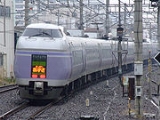
E351 series
Encyclopedia
The is a DC
electric multiple unit
operated by East Japan Railway Company
(JR East) on Chūō Main Line
Super Azusa
Limited express
services in Japan. First introduced in December 1993 (on Azusa services), the trains feature a tilting
mechanism. A total of 60 vehicles were built, formed as five 8-car main sets (numbers S1 to S5) and five 4-car supplementary (numbers S21 to S25) sets.
Chūō Main Line
Tōkaidō Main Line

local train that had overrun a red signal while passing through Ōtsuki Station. Several cars were derailed and one car overturned. Five cars of set S3 were ultimately cut up on site, and replacements ordered from Hitachi. The replacement vehicles received the same running numbers as those they replaced.
Direct current
Direct current is the unidirectional flow of electric charge. Direct current is produced by such sources as batteries, thermocouples, solar cells, and commutator-type electric machines of the dynamo type. Direct current may flow in a conductor such as a wire, but can also flow through...
electric multiple unit
Electric multiple unit
An electric multiple unit or EMU is a multiple unit train consisting of self-propelled carriages, using electricity as the motive power. An EMU requires no separate locomotive, as electric traction motors are incorporated within one or a number of the carriages...
operated by East Japan Railway Company
East Japan Railway Company
is the largest passenger railway company in the world and one of the seven Japan Railways Group companies. The company name is officially abbreviated as JR East in English, and as in Japanese. The company's headquarters are in Yoyogi, Shibuya, Tokyo....
(JR East) on Chūō Main Line
Chuo Main Line
The , commonly called the Chūō Line, is one of the major trunk railway lines in Japan. It runs between Tokyo and Nagoya, although it is the slowest direct railway connection between the two cities; the coastal Tōkaidō Main Line is slightly faster, while the Tōkaidō Shinkansen is the fastest rail...
Super Azusa
Azusa (train)
The and are limited express services operated by East Japan Railway , which run between Shinjuku and Matsumoto via the Chūō Main Line and Shinonoi Line.The name Azusa is taken from the Azusa River in Matsumoto, Nagano.-Azusa:-Super Azusa:...
Limited express
Limited express
A limited express is a type of express train service. It refers to an express service that stops at a limited number of stops in comparison to other express services on the same or similar routes.- Japan :...
services in Japan. First introduced in December 1993 (on Azusa services), the trains feature a tilting
Tilting train
A tilting train is a train that has a mechanism enabling increased speed on regular rail tracks. As a train rounds a curve at speed, objects inside the train experience centrifugal force. This can cause packages to slide about or seated passengers to feel squashed by the outboard armrest due to...
mechanism. A total of 60 vehicles were built, formed as five 8-car main sets (numbers S1 to S5) and five 4-car supplementary (numbers S21 to S25) sets.
Chūō Main LineChuo Main LineThe , commonly called the Chūō Line, is one of the major trunk railway lines in Japan. It runs between Tokyo and Nagoya, although it is the slowest direct railway connection between the two cities; the coastal Tōkaidō Main Line is slightly faster, while the Tōkaidō Shinkansen is the fastest rail...
- Super AzusaAzusa (train)The and are limited express services operated by East Japan Railway , which run between Shinjuku and Matsumoto via the Chūō Main Line and Shinonoi Line.The name Azusa is taken from the Azusa River in Matsumoto, Nagano.-Azusa:-Super Azusa:...
(since inception, December 1994) - Chūō LinerChuo LinerThe Chūō Liner is a limited-stop reserved-seat "Home Liner" service for commuters on the Chūō Rapid Line operated by East Japan Railway Company . The train operates on weekdays only...
(since 15 March 2008)
Tōkaidō Main LineTokaido Main LineThe is the busiest trunk line of the Japan Railways Group , connecting Tōkyō and Kōbe stations. It is long, not counting its many freight feeder lines around the major cities...
- Homeliner Odawara (Weekdays only)
- Ohayōliner Shinjuku (Weekdays only)
Super Azusa
| ←Shinjuku/Tokyo | Matsumoto/Minamiotari→ | |||||||||||
| 1 Reserved |
2 Reserved |
3 Non-reserved |
4 Non-reserved |
- | 5 Non-reserved |
6 Non-reserved |
7 Reserved |
8 Reserved |
9 Green |
10 Reserved |
11 Reserved |
12 Reserved |

Accidents
On 12 October 1997, the down Super Azusa 13 service from Shinjuku to Matsumoto (formed of sets S3+S23) was involved in a collision with a 201 series201 series
The is a commuter electric multiple unit train type introduced in 1979 by Japanese National Railways , and currently operated by West Japan Railway Company , and formerly also operated by East Japan Railway Company ....
local train that had overrun a red signal while passing through Ōtsuki Station. Several cars were derailed and one car overturned. Five cars of set S3 were ultimately cut up on site, and replacements ordered from Hitachi. The replacement vehicles received the same running numbers as those they replaced.

